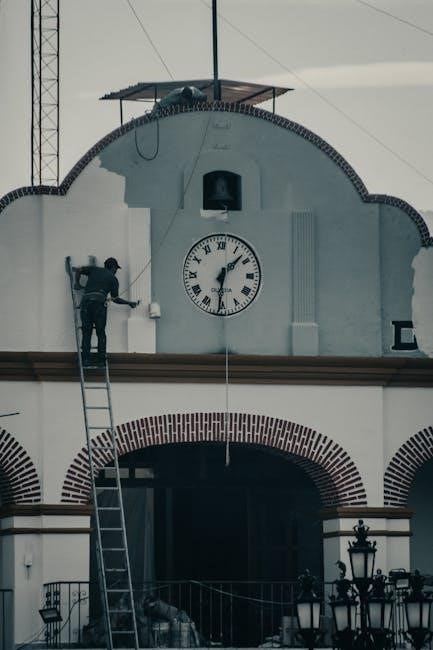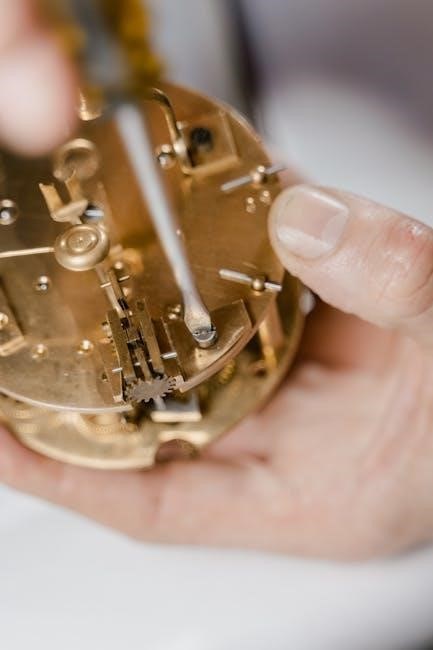A 400-Day Clock‚ also known as a torsion clock‚ is a mechanical timepiece designed to run for approximately one year on a single winding. Featuring a unique torsion spring or pendulum system‚ these clocks are renowned for their durability and precision‚ making them popular for anniversary celebrations and special occasions. Their long-running capability and elegant design have made them a cherished choice for both collectors and enthusiasts.
1.1 Definition and Overview of 400-Day Clocks
A 400-Day Clock‚ also known as an anniversary clock‚ is a mechanical timepiece designed to operate continuously for approximately one year (400 days) on a single winding. These clocks are characterized by their torsion spring or pendulum system‚ which ensures a slow and consistent release of energy‚ enabling their long-running capability. Known for their precision and durability‚ they are often used to commemorate special occasions. The clocks feature a unique design‚ with some incorporating rotating pendulums or decorative elements‚ making them popular as both functional timekeepers and cherished collector’s items.
1.2 Historical Background and Development
The 400-Day Clock‚ also known as an anniversary clock‚ has its roots in 19th-century Germany‚ where it was developed as a durable and precise timekeeping device. The concept evolved from earlier mechanical clocks‚ with the first models emerging in the mid-1800s. These clocks gained popularity in the early 20th century‚ particularly in the United States‚ where they became synonymous with celebrations and anniversaries. The design was refined by companies like Schatz‚ who pioneered the torsion spring mechanism‚ ensuring a 400-day runtime on a single winding. Over time‚ advancements in materials and craftsmanship further improved their reliability and aesthetics.
1.3 Unique Features of 400-Day Clocks
400-Day Clocks boast several distinctive features‚ including a torsion spring or pendulum system that powers the clock for an extended period. The mainspring releases energy slowly‚ ensuring consistent timekeeping. These clocks often feature a silent‚ rotating pendulum and a glass dome for protection. Their design emphasizes minimal maintenance‚ with a 400-day runtime between windings. Additionally‚ they include leveling screws for accuracy and a regulator to adjust timekeeping precision. These elements combine to create a durable‚ low-maintenance timepiece ideal for commemorative purposes‚ making them a favorite among collectors and those seeking a reliable‚ elegant clock.

Understanding the Mechanics of 400-Day Clocks
400-Day Clocks operate via a torsion spring or pendulum‚ powering the clock for up to 400 days. The escapement and balance wheel regulate timekeeping‚ ensuring accuracy and efficiency.
2.1 The Torsion Spring and Pendulum System
The torsion spring and pendulum system is the heart of a 400-Day Clock‚ enabling it to run for an extended period. The torsion spring stores energy when wound‚ releasing it gradually to power the clock. The pendulum oscillates in a consistent manner‚ regulating the release of energy and ensuring accurate timekeeping. This unique mechanism allows the clock to operate for up to 400 days on a single winding‚ making it a remarkable example of horological engineering. The system’s design emphasizes efficiency and precision‚ minimizing the need for frequent adjustments or maintenance.
2.2 Energy Release Mechanism
The energy release mechanism in 400-Day Clocks is designed for slow‚ consistent power delivery. The mainspring stores energy when wound‚ releasing it through a gear train to the escapement. This escapement regulates the release‚ ensuring precise timekeeping. The balance wheel oscillates‚ dividing time into equal parts‚ while the torsion spring powers the pendulum’s consistent swings. This mechanism allows the clock to run for up to 400 days on a single winding‚ minimizing the need for frequent adjustments. The system’s efficiency and reliability make it a cornerstone of these clocks’ enduring functionality.
2.3 The Role of the Mainspring
The mainspring is the primary power source in a 400-Day Clock‚ storing mechanical energy when wound. This spring powers the entire clock mechanism‚ driving the gears‚ escapement‚ and pendulum. Its slow‚ controlled release ensures a consistent energy supply‚ enabling the clock to run for up to 400 days. The mainspring’s design and quality are crucial for accurate timekeeping‚ with proper tension and lubrication essential to maintain its performance. Regular inspection and replacement are recommended to prevent fatigue and breakage‚ ensuring the clock’s longevity and reliability over extended periods.

Essential Tools and Materials for Repair
Eessential tools for 400-Day clock repairs include a mainspring winder‚ suspension wire replacement tools‚ and high-quality lubricants‚ all crucial for maintaining precise timekeeping and extending the clock’s life.
3.1 Clock Mainspring Winder
A clock mainspring winder is an essential tool for safely removing and rewinding the mainspring in 400-Day clocks. It prevents breakage and ensures proper tension‚ critical for accurate timekeeping. The winder allows precise control over the spring’s energy release‚ avoiding damage during maintenance or repair. Without it‚ handling the mainspring can lead to costly repairs. This specialized tool is indispensable for horologists and enthusiasts‚ enabling them to service the clock’s power source effectively while maintaining its long-running functionality.
3.2 Suspension Wire Replacement Tools
Suspension wire replacement tools are critical for servicing 400-Day clocks‚ as the delicate wire is prone to damage. These tools typically include specialized screwdrivers‚ pliers‚ and brackets designed to handle the intricate suspension system. The wire’s precision alignment and tension are vital for maintaining the clock’s accuracy. Replacement requires careful removal of the old wire and precise installation of the new one to avoid bending or misalignment. Spare suspension wires are often provided with the clock‚ emphasizing their importance in long-term maintenance. The Horolovar guide details these tools and their proper usage for successful repairs.
3.3 Lubricants and Cleaning Supplies
Lubricants and cleaning supplies are essential for maintaining the smooth operation and longevity of 400-Day clocks. High-quality clock oils are used to lubricate gears and pivot points‚ ensuring friction is minimized without attracting dust. Renaissance Wax is often recommended for protecting metal surfaces from tarnish and corrosion. Cleaning supplies like Simichrome Polish are used to remove grime and restore luster to brass components. Proper cleaning and lubrication are critical to prevent wear and tear‚ ensuring the clock’s precise timekeeping and mechanical integrity over its extended running period. These materials are emphasized in repair guides to uphold the clock’s performance and aesthetic appeal.

The Horolovar 400-Day Clock Repair Guide
The Horolovar 400-Day Clock Repair Guide is a comprehensive resource for repairing and maintaining these clocks. It includes detailed instructions‚ illustrations‚ and troubleshooting tips‚ making it indispensable for both professionals and enthusiasts.
4.1 Overview of the Guide and Its Importance
The Horolovar 400-Day Clock Repair Guide is a vital resource for anyone working with these intricate timepieces. It provides a detailed roadmap for identifying and addressing common issues‚ ensuring precise repairs. The guide’s comprehensive coverage‚ including troubleshooting techniques and maintenance tips‚ makes it an essential tool for both professionals and hobbyists. By following its step-by-step instructions‚ users can restore their clocks to optimal functionality‚ preserving their beauty and accuracy for years to come.
4.2 Key Chapters and Topics Covered
The Horolovar 400-Day Clock Repair Guide covers essential chapters‚ including the history of 400-Day clocks‚ torsion spring mechanisms‚ and troubleshooting common issues. It provides detailed instructions for repairing and maintaining key components like the escapement‚ gears‚ and strike mechanisms. The guide also includes sections on identifying faults‚ cleaning movements‚ and adjusting pendulums. With extensive illustrations and reference materials‚ it serves as a practical resource for both novice and experienced clock repairers‚ ensuring accurate and efficient restoration of these intricate timepieces.
4.3 The Evolution of the Guide (10th Edition)
The 10th edition of the Horolovar 400-Day Clock Repair Guide represents a significant evolution in clock repair resources. Originally a suspension spring guide‚ it expanded into a comprehensive manual covering repairs‚ troubleshooting‚ and maintenance. This edition features over 500 backplate illustrations‚ aiding in clock identification and part selection. Enhanced chapters on escapement adjustments‚ strike mechanisms‚ and gear repairs provide detailed insights. The inclusion of Charles Terwilliger’s expertise ensures updated techniques and solutions for modern clock repair challenges‚ solidifying its reputation as an indispensable tool for horologists and enthusiasts alike.

Step-by-Step Repair Process
The repair process involves systematic disassembly‚ cleaning‚ and reassembly‚ utilizing tools like mainspring winders and suspension wire replacements. Proper lubrication ensures smooth functionality and longevity.
5.1 Initial Setup and Preparation
Begin by carefully unboxing and inspecting the clock‚ ensuring all components are intact. Place the clock on a stable‚ vibration-free surface and remove the glass dome to access the mechanism. Gather essential tools‚ such as a mainspring winder and suspension wire replacement kit‚ and ensure a clean workspace. Lubricate moving parts lightly to prevent friction. Before making adjustments‚ allow the clock to operate for 48 hours to stabilize. This step ensures accurate diagnosis of any issues and prepares the clock for precise repairs‚ following the detailed guidelines outlined in the Horolovar repair manual.
5.2 Removing and Cleaning the Mainspring
Removing the mainspring requires precision to avoid damage. Use a mainspring winder to carefully unwind and extract the spring from its barrel. Once removed‚ clean the mainspring using specialized cleaning solutions to eliminate dirt and old lubricants. Inspect for any signs of wear or breakage‚ ensuring it remains flexible and functional. After cleaning‚ allow the spring to dry completely before reinstallation. Proper handling ensures the mainspring retains its energy-storing capacity‚ crucial for the clock’s 400-day operation. Always follow the detailed steps outlined in the Horolovar guide to maintain the spring’s integrity and functionality during the repair process.
5.3 Replacing the Suspension Wire
Replacing the suspension wire requires careful attention to avoid damaging the mechanism. Begin by removing the pendulum and loosening the thumb screw on the suspension wire protective tube. Gently slide the tube upward and remove the suspension wire assembly. Install the new suspension wire‚ ensuring it is securely fastened and properly aligned. Replace the protective tube and tighten the thumb screw. Finally‚ reattach the pendulum and ensure the clock is leveled. This process restores the clock’s balance and accuracy‚ as detailed in the Horolovar guide‚ ensuring proper functionality after repair.
5.4 Adjusting the Escapement and Balance
Adjusting the escapement and balance ensures precise timekeeping in a 400-Day Clock. The escapement’s beat must be even‚ with equal pendulum swings. If uneven‚ gently adjust the suspension wire’s position by loosening the screw and shifting the pillar. For balance‚ check the pendulum’s alignment with the brass cup. Use leveling screws to ensure the clock is perfectly horizontal. After adjustments‚ allow the clock to run for 24 hours before fine-tuning. Proper alignment and balance are crucial for maintaining accuracy and longevity‚ as outlined in the Horolovar guide for optimal performance.

Common Issues and Troubleshooting
Common issues include pendulum imbalance‚ broken suspension wires‚ and timekeeping inaccuracies. These problems often stem from improper leveling or worn components. The Horolovar guide provides detailed solutions.
6.1 Identifying Imbalance in the Pendulum
Imbalance in the pendulum is a common issue that affects the accuracy of 400-Day Clocks. It occurs when the pendulum’s rotational axis is uneven‚ causing uneven swings. To identify this‚ observe the pendulum’s movement through the backplate holes. If the lever and escape wheel alignment is off‚ the clock is out of beat. Uneven pendulum travel on either side indicates imbalance. Referencing the Horolovar guide‚ adjustments can be made by loosening the screw and aligning the suspension wire‚ ensuring symmetrical movement for precise timekeeping.
6.2 Fixing a Broken Suspension Wire
A broken suspension wire is a common issue in 400-Day Clocks‚ disrupting the pendulum’s function. To fix this‚ remove the pendulum and access the suspension wire assembly. Use the spare wire provided or a replacement from Horolovar. Loosen the thumb screw on the protecting tube‚ slide it off‚ and remove the suspension wire mounting bridge. Replace the wire assembly‚ ensuring the fork aligns with the lever. Reassemble by reversing the steps‚ then realign the clock’s beat for accurate timekeeping. Refer to the Horolovar guide for detailed instructions to ensure proper repair and functionality.

6.3 Addressing Timekeeping Inaccuracies
Timekeeping inaccuracies in 400-Day Clocks often stem from imbalances in the pendulum or issues with the suspension wire. To address this‚ ensure the clock is properly leveled using the leveling screws. Check the pendulum’s alignment and adjust the regulator disc as needed. If the clock loses or gains time‚ move the indicator hand on the disc in the appropriate direction. For persistent issues‚ consult the Horolovar guide for detailed adjustment techniques. Regular maintenance‚ such as cleaning and lubricating the movement‚ can also improve accuracy and ensure reliable timekeeping over the clock’s 400-day cycle.

Maintenance and Care Tips
Regular cleaning with a soft cloth and proper storage are essential. Avoid harsh chemicals and extreme temperatures. Wind the clock gently and fully every 400 days to maintain accuracy and functionality.
7.1 Regular Cleaning and Lubrication
Regular cleaning is essential to maintain the clock’s performance. Use a soft cloth to gently remove dust from the clock and glass dome. Avoid harsh chemicals or abrasive materials‚ as they may damage surfaces. Lubrication should be applied sparingly by a professional‚ focusing on critical moving parts. Proper care ensures the clock’s longevity and accuracy. Cleaning and maintenance should be performed every 1-2 years to prevent dust buildup and friction. Always refer to the repair guide for specific instructions tailored to your clock model.
7.2 Proper Storage and Handling
Proper storage and handling are crucial to preserve the clock’s functionality and appearance. Always handle the clock with care‚ as rough movements can damage the delicate suspension wire or pendulum. Store the clock in a protective case or original packaging to shield it from dust and scratches. Avoid exposing the clock to direct sunlight‚ moisture‚ or extreme temperatures. When moving the clock‚ ensure it is wound down to prevent internal stress. Place it on a level surface and avoid touching the pendulum or suspension wire. Regular handling can cause wear‚ so consider professional servicing if the clock is moved frequently.
7.3 Avoiding Common Damages
To avoid common damages‚ handle the clock with care‚ as rough movements can bend the suspension wire or misalign the pendulum. Avoid touching the pendulum or suspension wire excessively‚ as oils from skin can cause corrosion. Use a soft cloth to clean the clock and glass dome‚ avoiding harsh chemicals or abrasive materials. Store the clock in a protective case when not in use to prevent dust buildup and scratches. Ensure the clock is level during operation to maintain accurate timekeeping. Regular servicing by a professional can also prevent wear and tear‚ ensuring optimal performance for years.

The Role of the Pendulum in 400-Day Clocks
The pendulum plays a crucial role in regulating the clock’s movement by oscillating to divide time accurately. Its consistent rotation ensures precise timekeeping over the 400-day period.
8.1 Design and Function of the Pendulum
The pendulum in a 400-Day clock is a critical component‚ designed to oscillate in a consistent manner to regulate timekeeping. Unlike traditional pendulums‚ it often features a torsion spring mechanism‚ allowing for a compact and durable design. The pendulum’s rotation is controlled by a delicate suspension wire‚ ensuring precise movement. Its function is to divide time accurately‚ enabling the clock to maintain consistent operation over its extended runtime. The design also incorporates a regulating disc with markings‚ enabling fine adjustments to achieve optimal timekeeping accuracy and reliability.
8.2 Adjusting the Pendulum for Accuracy
Adjusting the pendulum in a 400-Day clock involves fine-tuning its oscillation to ensure precise timekeeping. The pendulum features a regulating disc with numbered markings and directional arrows (F-S). To correct timekeeping‚ move the disc in the indicated direction. For example‚ if the clock loses time‚ turn the disc toward “F” to speed it up. The small indicator hand points to a specific number‚ which can be adjusted to achieve accuracy. Ensure the clock is level and allow it to run for 24 hours before making further adjustments for optimal performance and reliability.
8.3 Preventing Pendulum Damage
To prevent pendulum damage‚ handle it with extreme care‚ avoiding bending or flexing the suspension wire. Never touch the pendulum while the clock is running‚ as this can disrupt its balance and accuracy. Store the clock on a stable‚ level surface away from vibrations or sudden movements. When transporting‚ secure the pendulum to prevent excessive swinging. Regularly inspect the suspension wire for signs of wear or fraying and replace it immediately if damaged. Proper care ensures the pendulum remains intact‚ maintaining the clock’s precision and longevity.

Advanced Repair Techniques
Advanced repair techniques focus on intricate mechanisms‚ such as replacing mainsprings‚ adjusting strike mechanisms‚ and fine-tuning escapements‚ ensuring precision and optimal performance in 400-Day Clocks.
9.1 Replacing the Mainspring
Replacing the mainspring in a 400-Day Clock requires precision and care. Begin by fully unwinding the clock to release stored energy. Remove the barrel‚ carefully extracting the old spring with specialized tools. Clean the barrel thoroughly before fitting the new mainspring‚ ensuring it is properly seated and aligned. Reassemble the mechanism‚ winding the spring gradually to avoid over-tension. Test the clock’s functionality to ensure accurate timekeeping and smooth operation after the replacement. Properly executed‚ this process restores the clock’s performance and longevity.
9.2 Adjusting the Strike Mechanism
Adjusting the strike mechanism in a 400-Day Clock involves fine-tuning the components responsible for chiming or striking the time. Ensure the strike train is properly lubricated and free from debris. Check the alignment of hammers and gongs‚ making adjustments to ensure precise contact. Regulate the strike speed and timing by tweaking the adjustment screws‚ referencing the manufacturer’s specifications. Test the mechanism by observing the strike sequence to ensure accuracy and harmony. Proper adjustment ensures the clock’s melodious chimes function flawlessly‚ enhancing its aesthetic and functional appeal while preserving its mechanical integrity.
9.3 Fine-Tuning the Escapement
Fine-tuning the escapement in a 400-Day Clock requires precision to ensure accurate timekeeping. Inspect the pallets and escape wheel for wear or damage‚ replacing them if necessary. Adjust the angle of the pallets and the depth of the escape wheel’s engagement using specialized tools. Ensure the escape wheel locks correctly with the pallets‚ maintaining consistent release; Test the escapement’s performance by observing the pendulum’s swing and the clock’s beat. Proper adjustment ensures smooth operation‚ minimal friction‚ and precise timekeeping‚ vital for the clock’s long-term reliability and performance over its 400-day cycle.
Mastering 400-Day Clock repair requires patience and skill. The Horolovar 400-Day Clock Repair Guide by Charles Terwilliger is an essential resource‚ offering detailed techniques and troubleshooting solutions.
10.1 Final Tips for Successful Repair
For successful repair‚ always use specialized tools like mainspring winders and follow the Horolovar 400-Day Clock Repair Guide. Regularly clean and lubricate moving parts to ensure smooth operation. Handle suspension wires with care to avoid breakage. When winding‚ turn the key counterclockwise in small increments to prevent spring damage. If the clock loses accuracy‚ adjust the pendulum disc as instructed. For complex issues‚ consult the guide or seek professional help. Proper storage and handling will extend the clock’s lifespan‚ ensuring it runs reliably for years. Patience and attention to detail are key to mastering these unique timepieces.
10.2 Recommended Reading and Resources
The Horolovar 400-Day Clock Repair Guide by Charles Terwilliger is a must-have resource‚ offering detailed repair techniques and troubleshooting. It includes comprehensive coverage of suspension springs‚ mainsprings‚ and escapement adjustments. The 10th edition is particularly recommended for its extensive illustrations and parts identification. Additionally‚ the Schatz Standard 400-Day Clock Instruction Sheet from 1959 provides valuable setup and care instructions. For digital convenience‚ a PDF version of the repair guide is available‚ ensuring easy access to essential information. These resources are invaluable for both professionals and enthusiasts‚ aiding in successful repair and maintenance of 400-Day clocks.





